Logistic Regression
The Data
我们将建立一个逻辑回归模型来预测一个学生是否被大学录取。假设你是一个大学系的管理员,你想根据两次考试的结果来决定每个申请人的录取机会。你有以前的申请人的历史数据,你可以用它作为逻辑回归的训练集。对于每一个培训例子,你有两个考试的申请人的分数和录取决定。为了做到这一点,我们将建立一个分类模型,根据考试成绩估计入学概率。
# 三大件
import numpy as np
import pandas as pd
import matplotlib.pyplot as plt
%matplotlib inline
import os
path = 'data'+os.sep+'LogiReg_data.txt'
pdData = pd.read_csv(path,header=None,names=['Exam 1','Exam 2','Admitted'])
pdData.head()
| Exam 1 | Exam 2 | Admitted | |
|---|---|---|---|
| 0 | 34.623660 | 78.024693 | 0 |
| 1 | 30.286711 | 43.894998 | 0 |
| 2 | 35.847409 | 72.902198 | 0 |
| 3 | 60.182599 | 86.308552 | 1 |
| 4 | 79.032736 | 75.344376 | 1 |
pdData.shape
(100, 3)
positive = pdData[pdData['Admitted']==1]
negative = pdData[pdData['Admitted']==0]
negative.head()
fig,ax = plt.subplots(figsize=(10,5))
ax.scatter(positive['Exam 1'],positive['Exam 2'],s=30,c='b',marker='o',label='Admitted')
ax.scatter(negative['Exam 1'],negative['Exam 2'],s=30,c='r',marker='x',label='Not Admitted')
ax.legend()
ax.set_xlabel('Exam 1 Score')
ax.set_ylabel('Exam 2 Score')
Text(0, 0.5, 'Exam 2 Score')
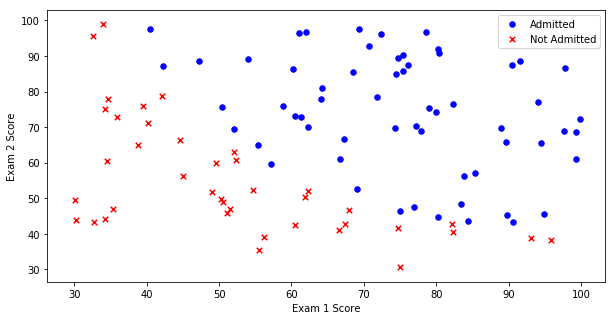
The logistic regression
目标:建立分类器(求解出三个参数( heta_0, heta_1, heta_2))
设定阈值,根据阈值判断录取结果
要完成的模块
sigmoid:映射到概率的函数model:返回预测结果值cost:根据参数计算损失gradient:计算每个参数的梯度方向descent:进行参数更新accuracy:计算精度
Sigmoid 函数
[g(z) = frac{1}{1+e^{-z}}
]
- (g:mathbb{R} o [0,1])
- (g(0)=0.5)
- (g(- infty)=0)
- (g(+ infty)=1)
def sigmoid(z):
return 1/(1+np.exp(-z))
nums = np.arange(-10,10,step=1)
print(nums)
fig,ax = plt.subplots(figsize=(12,4))
ax.plot(nums,sigmoid(nums),'r')
plt.show()
[-10 -9 -8 -7 -6 -5 -4 -3 -2 -1 0 1 2 3 4 5 6 7
8 9]
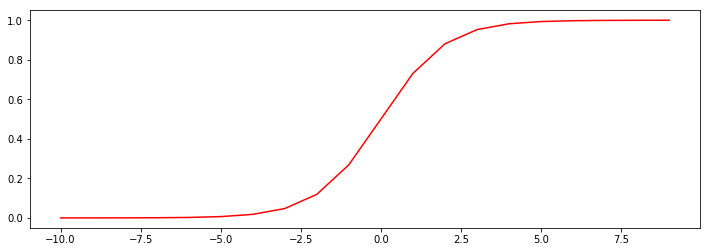
def model(X,theta):
""" Returns our model result
:param X: examples to classify, m x p
:param theta: parameters, p x 1
:return: the sigmoid evaluated for each examples in X given parameters theta as a m x 1 vector
"""
return sigmoid(np.matmul(X,theta))
[egin{array}{ccc}
egin{pmatrix} 1 & x_{1} & x_{2}end{pmatrix} & imes & egin{pmatrix} heta_{0}\
heta_{1}\
heta_{2}
end{pmatrix}end{array}= heta_{0}+ heta_{1}x_{1}+ heta_{2}x_{2}
]
pdData.insert(0,'Ones',1)
pdData.head()
# set X (training data) and y (target variable)
orig_data = pdData.as_matrix() # convert the Pandas representation of the data to an array useful for further computations
print(orig_data)
cols = orig_data.shape[1]
print(cols)
X = orig_data[:,0:cols-1]
y = orig_data[:,cols-1:cols]
# print(X[:5])
theta = np.zeros([cols-1,1])
[[ 1. 34.62365962 78.02469282 0. ]
[ 1. 30.28671077 43.89499752 0. ]
[ 1. 35.84740877 72.90219803 0. ]
[ 1. 60.18259939 86.3085521 1. ]
[ 1. 79.03273605 75.34437644 1. ]
[ 1. 45.08327748 56.31637178 0. ]
[ 1. 61.10666454 96.51142588 1. ]
[ 1. 75.02474557 46.55401354 1. ]
[ 1. 76.0987867 87.42056972 1. ]
[ 1. 84.43281996 43.53339331 1. ]
[ 1. 95.86155507 38.22527806 0. ]
[ 1. 75.01365839 30.60326323 0. ]
[ 1. 82.30705337 76.4819633 1. ]
[ 1. 69.36458876 97.71869196 1. ]
[ 1. 39.53833914 76.03681085 0. ]
[ 1. 53.97105215 89.20735014 1. ]
[ 1. 69.07014406 52.74046973 1. ]
[ 1. 67.94685548 46.67857411 0. ]
[ 1. 70.66150955 92.92713789 1. ]
[ 1. 76.97878373 47.57596365 1. ]
[ 1. 67.37202755 42.83843832 0. ]
[ 1. 89.67677575 65.79936593 1. ]
[ 1. 50.53478829 48.85581153 0. ]
[ 1. 34.21206098 44.2095286 0. ]
[ 1. 77.92409145 68.97235999 1. ]
[ 1. 62.27101367 69.95445795 1. ]
[ 1. 80.19018075 44.82162893 1. ]
[ 1. 93.1143888 38.80067034 0. ]
[ 1. 61.83020602 50.25610789 0. ]
[ 1. 38.7858038 64.99568096 0. ]
[ 1. 61.37928945 72.80788731 1. ]
[ 1. 85.40451939 57.05198398 1. ]
[ 1. 52.10797973 63.12762377 0. ]
[ 1. 52.04540477 69.43286012 1. ]
[ 1. 40.23689374 71.16774802 0. ]
[ 1. 54.63510555 52.21388588 0. ]
[ 1. 33.91550011 98.86943574 0. ]
[ 1. 64.17698887 80.90806059 1. ]
[ 1. 74.78925296 41.57341523 0. ]
[ 1. 34.18364003 75.23772034 0. ]
[ 1. 83.90239366 56.30804622 1. ]
[ 1. 51.54772027 46.85629026 0. ]
[ 1. 94.44336777 65.56892161 1. ]
[ 1. 82.36875376 40.61825516 0. ]
[ 1. 51.04775177 45.82270146 0. ]
[ 1. 62.22267576 52.06099195 0. ]
[ 1. 77.19303493 70.4582 1. ]
[ 1. 97.77159928 86.72782233 1. ]
[ 1. 62.0730638 96.76882412 1. ]
[ 1. 91.5649745 88.69629255 1. ]
[ 1. 79.94481794 74.16311935 1. ]
[ 1. 99.27252693 60.999031 1. ]
[ 1. 90.54671411 43.39060181 1. ]
[ 1. 34.52451385 60.39634246 0. ]
[ 1. 50.28649612 49.80453881 0. ]
[ 1. 49.58667722 59.80895099 0. ]
[ 1. 97.64563396 68.86157272 1. ]
[ 1. 32.57720017 95.59854761 0. ]
[ 1. 74.24869137 69.82457123 1. ]
[ 1. 71.79646206 78.45356225 1. ]
[ 1. 75.39561147 85.75993667 1. ]
[ 1. 35.28611282 47.02051395 0. ]
[ 1. 56.2538175 39.26147251 0. ]
[ 1. 30.05882245 49.59297387 0. ]
[ 1. 44.66826172 66.45008615 0. ]
[ 1. 66.56089447 41.09209808 0. ]
[ 1. 40.45755098 97.53518549 1. ]
[ 1. 49.07256322 51.88321182 0. ]
[ 1. 80.27957401 92.11606081 1. ]
[ 1. 66.74671857 60.99139403 1. ]
[ 1. 32.72283304 43.30717306 0. ]
[ 1. 64.03932042 78.03168802 1. ]
[ 1. 72.34649423 96.22759297 1. ]
[ 1. 60.45788574 73.0949981 1. ]
[ 1. 58.84095622 75.85844831 1. ]
[ 1. 99.8278578 72.36925193 1. ]
[ 1. 47.26426911 88.475865 1. ]
[ 1. 50.4581598 75.80985953 1. ]
[ 1. 60.45555629 42.50840944 0. ]
[ 1. 82.22666158 42.71987854 0. ]
[ 1. 88.91389642 69.8037889 1. ]
[ 1. 94.83450672 45.6943068 1. ]
[ 1. 67.31925747 66.58935318 1. ]
[ 1. 57.23870632 59.51428198 1. ]
[ 1. 80.366756 90.9601479 1. ]
[ 1. 68.46852179 85.5943071 1. ]
[ 1. 42.07545454 78.844786 0. ]
[ 1. 75.47770201 90.424539 1. ]
[ 1. 78.63542435 96.64742717 1. ]
[ 1. 52.34800399 60.76950526 0. ]
[ 1. 94.09433113 77.15910509 1. ]
[ 1. 90.44855097 87.50879176 1. ]
[ 1. 55.48216114 35.57070347 0. ]
[ 1. 74.49269242 84.84513685 1. ]
[ 1. 89.84580671 45.35828361 1. ]
[ 1. 83.48916274 48.3802858 1. ]
[ 1. 42.26170081 87.10385094 1. ]
[ 1. 99.31500881 68.77540947 1. ]
[ 1. 55.34001756 64.93193801 1. ]
[ 1. 74.775893 89.5298129 1. ]]
4
C:MyProgramsAnaconda3libsite-packagesipykernel_launcher.py:5: FutureWarning: Method .as_matrix will be removed in a future version. Use .values instead.
"""
X[:5]
array([[ 1. , 34.62365962, 78.02469282],
[ 1. , 30.28671077, 43.89499752],
[ 1. , 35.84740877, 72.90219803],
[ 1. , 60.18259939, 86.3085521 ],
[ 1. , 79.03273605, 75.34437644]])
y[:5]
array([[0.],
[0.],
[0.],
[1.],
[1.]])
theta
array([[0.],
[0.],
[0.]])
X.shape,y.shape,theta.shape
((100, 3), (100, 1), (3, 1))
损失函数
将对数似然函数去负号
[D(h_ heta(x), y) = -ylog(h_ heta(x)) - (1-y)log(1-h_ heta(x))
]
求平均损失
[J( heta)=frac{1}{m}sum_{i=1}^{m} D(h_ heta(x_i), y_i)
]
def costFunction(X,y,theta):
left = np.multiply(-y,np.log(model(X,theta))) # 同*,元素级乘法
right = np.multiply((1-y),np.log(1-model(X,theta)))
return np.sum(left-right)/(len(X))
costFunction(X,y,theta)
0.6931471805599453
计算梯度
[frac{partial J}{partial heta_j}=-frac{1}{m}sum_{i=1}^m (y_i - h_ heta (x_i))x^i_{j}
]
[egin{pmatrix}frac{partial J}{partial heta_0}\
frac{partial J}{partial heta_1}\
frac{partial J}{partial heta_2}
end{pmatrix}=-frac{1}{m}egin{pmatrix} 1 & cdots & 1\
x^1_{1} & cdots & x^m_{1}\
x^1_{2}& cdots & x^m_{2}end{pmatrix}egin{pmatrix}y_1 - h_ heta (x_1)\
vdots\
y_m - h_ heta (x_m)
end{pmatrix}=frac{1}{m}X^T(h_ heta(x)-y)
]
def gradient(X,y,theta):
grad = np.zeros(theta.shape)
# error = (model(X, theta)- y).ravel()
# for j in range(len(theta.ravel())): #for each parmeter
# term = np.multiply(error, X[:,j])
# grad[0, j] = np.sum(term) / len(X)
error = np.matmul(X.T,(model(X,theta)-y))
grad = error/len(X)
return grad
gradient(X,y,theta)
array([[ -0.1 ],
[-12.00921659],
[-11.26284221]])
Gradient descent
比较3种不同梯度下降方法
STOP_ITER = 0
STOP_COST = 1
STOP_GRAD = 2
def stopCriterion(type,value,threshold):
# 设定三种不同的停止策略
if type == STOP_ITER: return value > threshold
elif type == STOP_COST: return abs(value[-1]-value[-2]) < threshold
elif type == STOP_GRAD: return np.linalg.norm(value) < threshold
import time
def descent(data,theta,batchSize, stopType, thresh,alpha):
#梯度下降求解
init_time = time.time()
i = 0 # 迭代次数
k = 0 # batch
X,y = shuffleData(data)
grad = np.zeros(theta.shape) # 计算梯度
costs = [costFunction(X,y,theta)] # 损失值
while True:
grad = gradient(X[k:k+batchSize],y[k:k+batchSize],theta)
k += batchSize # 取batch数量个数据
if k >= n:
k = 0;
X,y = shuffleData(data) # 重新洗牌
theta = theta - alpha*grad # 参数更新
costs.append(costFunction(X,y,theta)) # 计算新的损失
i += 1
if stopType == STOP_ITER: value = i
elif stopType == STOP_COST: value = costs
elif stopType == STOP_GRAD: value = grad
if stopCriterion(stopType,value,thresh): break
return theta,i-1,costs,grad,time.time()-init_time
import numpy.random
# 洗牌
def shuffleData(data):
np.random.shuffle(data)
cols = data.shape[1]
X = data[:, 0:cols-1]
y = data[:, cols-1:]
return X, y
def runExpe(data, theta, batchSize, stopType, thresh, alpha):
#import pdb; pdb.set_trace();
theta, iter, costs, grad, dur = descent(data, theta, batchSize, stopType, thresh, alpha)
name = "Original" if (data[:,1]>2).sum() > 1 else "Scaled"
name += " data - learning rate: {} - ".format(alpha)
if batchSize==n: strDescType = "Gradient"
elif batchSize==1: strDescType = "Stochastic"
else: strDescType = "Mini-batch ({})".format(batchSize)
name += strDescType + " descent - Stop: "
if stopType == STOP_ITER: strStop = "{} iterations".format(thresh)
elif stopType == STOP_COST: strStop = "costs change < {}".format(thresh)
else: strStop = "gradient norm < {}".format(thresh)
name += strStop
print ("***{}
Theta: {} - Iter: {} - Last cost: {:03.2f} - Duration: {:03.2f}s".format(
name, theta, iter, costs[-1], dur))
fig, ax = plt.subplots(figsize=(12,4))
ax.plot(np.arange(len(costs)), costs, 'r')
ax.set_xlabel('Iterations')
ax.set_ylabel('Cost')
ax.set_title(name.upper() + ' - Error vs. Iteration')
return theta
不同的停止策略
设定迭代次数
#选择的梯度下降方法是基于所有样本的
n=100
runExpe(orig_data, theta, n, STOP_ITER, thresh=5000, alpha=0.000001)
***Original data - learning rate: 1e-06 - Gradient descent - Stop: 5000 iterations
Theta: [[-0.00027127]
[ 0.00705232]
[ 0.00376711]] - Iter: 5000 - Last cost: 0.63 - Duration: 1.65s
array([[-0.00027127],
[ 0.00705232],
[ 0.00376711]])

根据损失值停止
设定阈值为1E-6
runExpe(orig_data, theta, n, STOP_COST, thresh=0.000001, alpha=0.001)
***Original data - learning rate: 0.001 - Gradient descent - Stop: costs change < 1e-06
Theta: [[-5.13364014]
[ 0.04771429]
[ 0.04072397]] - Iter: 109901 - Last cost: 0.38 - Duration: 48.19s
array([[-5.13364014],
[ 0.04771429],
[ 0.04072397]])

对比不同的梯度下降法
Stochastic descent
runExpe(orig_data, theta, 1, STOP_ITER, thresh=5000, alpha=0.001)
***Original data - learning rate: 0.001 - Stochastic descent - Stop: 5000 iterations
Theta: [[-0.39554857]
[ 0.02237485]
[-0.0276303 ]] - Iter: 5000 - Last cost: 0.89 - Duration: 0.76s
array([[-0.39554857],
[ 0.02237485],
[-0.0276303 ]])

有点爆炸。。。很不稳定,再来试试把学习率调小一些
runExpe(orig_data, theta, 1, STOP_ITER, thresh=15000, alpha=0.000002)
***Original data - learning rate: 2e-06 - Stochastic descent - Stop: 15000 iterations
Theta: [[-0.00202176]
[ 0.01001261]
[ 0.00091419]] - Iter: 15000 - Last cost: 0.63 - Duration: 1.86s
array([[-0.00202176],
[ 0.01001261],
[ 0.00091419]])
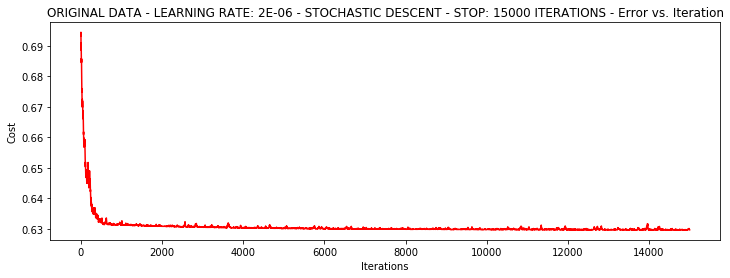
速度快,但稳定性差,需要很小的学习率
Mini-batch descent
runExpe(orig_data, theta, 16, STOP_ITER, thresh=15000, alpha=0.001)
***Original data - learning rate: 0.001 - Mini-batch (16) descent - Stop: 15000 iterations
Theta: [[-1.03466277]
[ 0.02768388]
[ 0.01858675]] - Iter: 15000 - Last cost: 0.72 - Duration: 2.89s
array([[-1.03466277],
[ 0.02768388],
[ 0.01858675]])

浮动仍然比较大,我们来尝试下对数据进行标准化 将数据按其属性(按列进行)减去其均值,然后除以其方差。最后得到的结果是,对每个属性/每列来说所有数据都聚集在0附近,方差值为1
from sklearn import preprocessing as pp
scaled_data = orig_data.copy()
scaled_data[:, 1:3] = pp.scale(orig_data[:, 1:3])
runExpe(scaled_data, theta, n, STOP_ITER, thresh=5000, alpha=0.001)
***Scaled data - learning rate: 0.001 - Gradient descent - Stop: 5000 iterations
Theta: [[0.3080807 ]
[0.86494967]
[0.77367651]] - Iter: 5000 - Last cost: 0.38 - Duration: 2.30s
array([[0.3080807 ],
[0.86494967],
[0.77367651]])
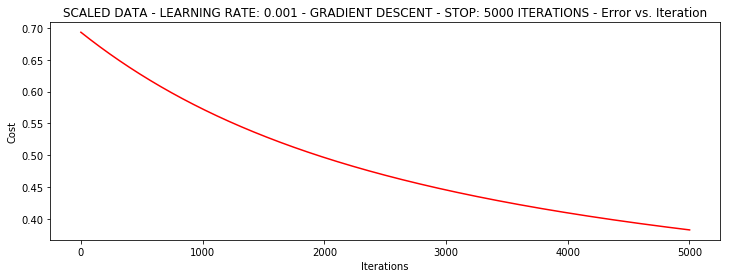
它好多了!原始数据,只能达到达到0.61,而我们得到了0.38个在这里! 所以对数据做预处理是非常重要的
runExpe(scaled_data, theta, n, STOP_GRAD, thresh=0.02, alpha=0.001)
***Scaled data - learning rate: 0.001 - Gradient descent - Stop: gradient norm < 0.02
Theta: [[1.0707921 ]
[2.63030842]
[2.41079787]] - Iter: 59422 - Last cost: 0.22 - Duration: 31.39s
array([[1.0707921 ],
[2.63030842],
[2.41079787]])

更多的迭代次数会使得损失下降的更多!
theta = runExpe(scaled_data, theta, 1, STOP_GRAD, thresh=0.002/5, alpha=0.001)
***Scaled data - learning rate: 0.001 - Stochastic descent - Stop: gradient norm < 0.0004
Theta: [[1.14837004]
[2.7936333 ]
[2.5646749 ]] - Iter: 72578 - Last cost: 0.22 - Duration: 13.34s
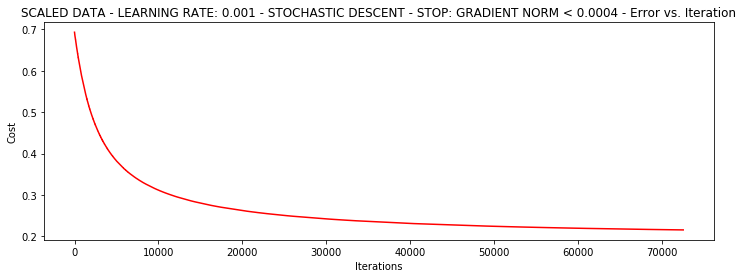
随机梯度下降更快,但是我们需要迭代的次数也需要更多,所以还是用batch的比较合适!!!
runExpe(scaled_data, theta, 16, STOP_GRAD, thresh=0.002*2, alpha=0.001)
***Scaled data - learning rate: 0.001 - Mini-batch (16) descent - Stop: gradient norm < 0.004
Theta: [[1.17941228]
[2.8498756 ]
[2.62631998]] - Iter: 5690 - Last cost: 0.21 - Duration: 1.33s
array([[1.17941228],
[2.8498756 ],
[2.62631998]])
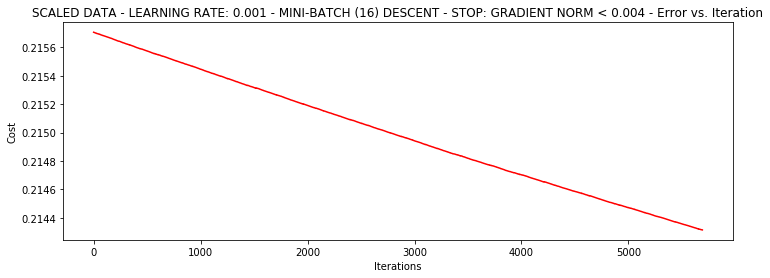
精度
#设定阈值
def predict(X, theta):
return [1 if x >= 0.5 else 0 for x in model(X, theta)]
scaled_X = scaled_data[:, :3]
y = scaled_data[:, 3]
predictions = predict(scaled_X, theta)
correct = [1 if ((a == 1 and b == 1) or (a == 0 and b == 0)) else 0 for (a, b) in zip(predictions, y)]
accuracy = (sum(map(int, correct)) % len(correct))
print ('accuracy = {0}%'.format(accuracy))
accuracy = 89%